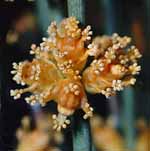 Ephedra viridis, male flowers in cone [Ken Gardiner] (4). | Ephedra viridis Coville 1893Common NamesGreen ephedra (1), mountain joint fir (2), Mormon tea, Brigham tea (3).Taxonomic notesSyn: Ephedra nevadensis Watson subvar. pluribracteata Palmer ex Stapf; E. nevadensis var. viridis (Coville) Jones (1).Description"Shrubs erect, 0.5-1 m. Bark gray, cracked and irregularly fissured. Branches alternate or whorled, rigid, angle of divergence about 30°. Twigs bright green to yellow-green, becoming yellow with age, not viscid, ridges between longitudinal grooves barely papillate, smooth; internodes 1-5 cm. Terminal buds conic, 1-2 mm, apex obtuse. Leaves opposite, 2-5 mm, connate to 1/2-3/4 their length, not photosynthetic; bases thickened, brown, persistent, becoming hard, enlarged, and black; apex setaceous. Pollen cones 2-several at node, obovoid, 5-7 mm, sessile; bracts opposite, 6-10 pairs, light yellow and slightly reddened, ovate, 2-4 × 2-3 mm, membranous, slightly connate at base; bracteoles slightly exceeding bracts; sporangiophores 2-4 mm, 1/4-1/2 exserted, with 5-8 sessile to nearly sessile microsporangia. Seed cones 2-several at node, obovoid, 6-10 mm, sessile or on short, scaly peduncles; bracts opposite, 4-8 pairs, ovate, 4-7 × 2-4 mm, membranous or papery, with yellow center and base, margins entire. Seeds 2, ellipsoid, 5-8 × 2-4 mm, light brown to brown, smooth. 2n = 28. ... Coning spring" (1).RangeUSA: Oregon, California, Arizona, Nevada, Utah, Wyoming, Colorado & New Mexico at 100-2500 m in piñon-juniper woodland and the Mojave desert, usually on dry rocky slopes and canyon walls (1, 2).Big TreeOldestDendrochronologyEthnobotany"The Navajo brewed the tops into a drink for use as a cough medicine. Other indians roasted the seeds, ate them whole or ground them into a meal for various uses" (3).ObservationsRemarksCitations(1) Dennis W. Stevenson at the Flora of North America online.(2) Jaeger 1969. (3) Elmore & Janish 1976. (4) The Blazing Star website. |
[Ephedra] [Ephedraceae] [home] This page is from the Gymnosperm Database |